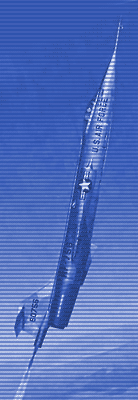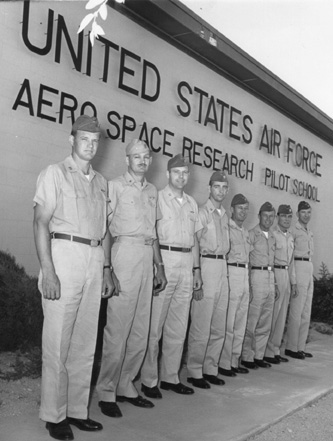The Mission > home

|
|
|
|
|
|
 |
The Mission click on the links below for more of the story...
|
||||||||||||||||||||||
1. BIRTH OF A SPACEPLANEThe decade of 1960’s had arrived and the Air Force was preparing for new military responsibilities in space, beyond the limit of ballistic missiles. The idea of space vehicles ultimately being quickly responsive to demands for frequent launch and recovery, with no more than a runway. The X-20, Dynasoar, expected to be our first spaceplane, was on contract with Boeing Aircraft and under design. This was to be an experimental craft, upon which to build the military concept and capability. The Air Force. had been test flying lifting body designs for such vehicles, and studying the difficult trade-offs for design of reentry and dissipation of the tremendous heat loads of reentry to the atmosphere. Dynasoar would require that a missile power it into orbit, but reenter the atmosphere and land on a runway, under pilot control. It might be thought of as a one man Space Shuttle, without thermal protection tiles.
Experienced test pilots would need additional training for the segment of such flights that would involve controlling in space, where a vehicle handles very differently and to perform the dicey task of manually flying reentry, something not accomplished to this day (for example on Shuttle reentry). The Aerospace Research Pilots School (ARPS) was created to provide that training. Members of Class I were selected, based on their education and ability, to research and develop an academic curriculum, which they did very effectively. Col. Robert ‘Buck” Buchanan, and Major Tom McElmurry along with civilian engineer and instructor Bill Schweikhard, were the initial commander and staff for it. These three and two students, soon to become NASA astronauts, in Gemini and Apollo spacecraft, Frank Borman and James McDivitt, were designated as Class I. In fact, they had the vital job to research and study in the process of developing the curriculum for those test pilots who would follow. In the process of developing the studies for ARPS they realized that related flying would be necessary to fully train test pilots. They opted to try a spin-off of the F-104A fighters, which were being used in the Test Pilot School at that time. Working in conjunction with Lockheed Aircraft Co., an amazing concept was conceived. It was a credit to their technical capabilities and foresight that they recognized the potential for an ordinary fighter in which students flew zoom climbs to about 85,000 feet, to be changed to an aircraft that could duplicate the environment of space. That new trainer for ARPS would have to fly well above that level to be able to simulate space flight conditions in training. Maybe more important to their success was the way they approached acquiring the aircraft. It was inventive and cost-effective, but most importantly they figured out how to avoid the approval loop necessary for austerity and their expedient acquisition. Without such ‘creative’ planning, the project could never have existed. Buchanan and staff, with Lockheed counterparts in Burbank, California were getting it done. They had fiscal foresight and technical acumen to find a way to do what they intended within a budget yet not let the cat out of the bag on just how monumental the change would really be. The Aerospace Trainer (AST), which Lockheed dubbed it, came closer to being an X-plane than an N-model (N=nonstandard), considering the magnitude of its physical changes and quantum performance increases. Those changes (AST Configuration) included the addition of a liquid rocket motor, LR 2-3, which had powered the Bell X1-A on the first supersonic flight by Chuck Yeager. And, the addition of a dozen monopropellant rocket thrusters at the command of the pilot to control flight outside the sensible atmosphere. This reaction control system (RCS) called upon existing hardware from the existing liquid rockets used to control the pure rocket X-15 in the manner that space capsules and Shuttles are controlled. Numerous other mods, some uncanny in their simple solutions for difficult requirements, were also necessary. A fully pressurized cockpit was necessary since an inflated pressure suit was needed in emergency but not compatible with precise pilot control functions. An oxygen-pressurized cockpit would be explosive at high altitude, as later sparked the conflagration of the Apollo capsule, during a manned pre-launch test. Therefore pressurized nitrogen gas was selected but entailed drawbacks, one of which came within seconds of costing my life. It was recognized and accepted that safety margins would be significantly shaved to attain such training for astronauts whose lives were measured against such necessary risks. Significant changes in flight instruments were necessary for a pilot to control in near-space, and here again they conceived unique modifications of existing equipment. The primary gage for controlling flight above the atmosphere was adapted from the Navy’s standard All-Attitude Reference System (AARS), which already had pitch and roll indicators. They simply revised the Instrument Landing System (ILS) needles into indicators of angle of attack (alpha) and side-slip (beta). Both of these would become absolutely necessary to control the airplane in all axes, when it became a spaceplane. The addition of a long nose probe with special, large alpha and beta vanes made this possible at very low dynamic pressure (q), near space. The project was approved, and managed under the school, but with testing to be accomplished by the Air Force Flight Test Center, Test Division, before the planned turnover of the 3 AST airplanes to the ARPS. The design and major modification to convert the standard airplanes into the AST configuration were accomplished by a small team of Lockheed Aircraft employees in the company’s Burbank plant in California. The performance (Zoom Profile) of the AST would be a leap forward in the zoom flights that the school was flying with standard NF-104A airplanes. The design maneuver, maximum zoom, was calculated to reach as high as 120,000 feet on a 70 degree climb. It would result in a combination of high altitude and low q that would allow true and necessary control by reaction control and loss of normal aerodynamic control accompanied by a change from a stable airplane to unstable spaceplane. The X-15 would have been a more perfect trainer, as seen by comparing performance but economically unfeasible, since its operation for a few missions would take a year and cost more than the combined acquisition and operating costs of AST.
A comparative table of performance shows the
huge margin of performance of the X-15 had over
the AST. This table of typical flight conditions
for the Aerospace Trainer at the apex of a zoom
climb to 100, 110 and 120 thousand feet, showing
Mach number, true velocity, dynamic pressure and
approximate equivalent airspeed, indicated to
the pilot slightly lower due to compressibility,
followed by the ultimate capability of the X-15. Typical Flight Conditions for the AST
The X-15 flight conditions at the top of the maximum design altitude mission were; alt.=250,000 ft., Mach=4.8, dynamic pressure=2.5 psf. The ball nose (alpha-beta sensor) was designed to operate down to a q of 2 psf, and it did. For higher altitude the q was about 0.5 psf and the ball nose would wander around. It also responded to reaction control inputs, moving sharply towards a nose-firing rocket. The World Altitude Record is 354,200 feet, at Mach 4 flown by NASA Joe Walker, who died in the XB-70 crash addressed in Smith autobiography, Chapter 4. |
| next section |
